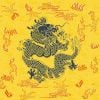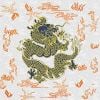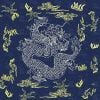Eight Banners
- This article is about the former administrative divisions of China.
| This article contains Chinese text. Without proper rendering support, you may see question marks, boxes, or other symbols instead of Chinese characters. |
The Eight Banners (In Manchu: ![]() jakūn gūsa, In Chinese: 八旗 baqí) were administrative military divisions which provided the basic framework for the Manchu military organization. The banners were first established by Nurhaci (1558 – 1626) the founder of the Manchu Qing dynasty in China in the early seventeenth century and grew to become the core elite of the Qing empire.
jakūn gūsa, In Chinese: 八旗 baqí) were administrative military divisions which provided the basic framework for the Manchu military organization. The banners were first established by Nurhaci (1558 – 1626) the founder of the Manchu Qing dynasty in China in the early seventeenth century and grew to become the core elite of the Qing empire.
The fundamental building block of the banners was the company (Manchu: ![]() niru, Chinese: 佐領 zuoling), some of which reflected pre-existing lineage or tribal connections in their membership while others deliberately overrode such connections in an effort to create a more centralized military force. Each company was, in principle, required to furnish 300 troops to the larger banner army. The Qing dynasty spent one quarter of its annual budget to maintain 18 walled garrisons of “bannermen” at strategic points throughout the empire. Membership in the Eight Banners was hereditary; members held an elite status and were required to follow certain political and social regulations.
niru, Chinese: 佐領 zuoling), some of which reflected pre-existing lineage or tribal connections in their membership while others deliberately overrode such connections in an effort to create a more centralized military force. Each company was, in principle, required to furnish 300 troops to the larger banner army. The Qing dynasty spent one quarter of its annual budget to maintain 18 walled garrisons of “bannermen” at strategic points throughout the empire. Membership in the Eight Banners was hereditary; members held an elite status and were required to follow certain political and social regulations.
Establishment
The banners were established by Nurhaci (1558 – 1626), the founder of the Manchu Qing dynasty in China, in the early seventeenth century (1615, according to noted historian, Peter C. Perdue) and grew to become the core elite of the Qing empire. Nurhaci adapted the Manchu tradition of organizing the people into temporary groups, called niulu, in times of military or agricultural crisis, and adapted it into a long-term formal organization. The basic unit of organization was called a “niulu” and contained three hundred people. Every niulu had a Niulu Ezhen (Watch Leader); every five niulus had a Jiala Ezhen (Canling), and every five Jiala formed a Gushan, or Banner. The Banner leader was called a Gushan Ezhen (commander-in-chief) or Gushan Beile.
Nurhaci divided all the Nurzhen tribes into patrilineal organizations of Eight Banners. In 1601, he set up the yellow banner, the white banner, the red banner and the blue banner. In 1615, he added the border yellow Banner, the border white Banner, the border red Banner and the border blue Banner, and assigned leadership of each Banner to one of his sons or nephews.
In 1616, Nurhaci proclaimed the establishment of the Jin dynasty, and began to expand his territory and engage the Ming forces. Nurhaci consistently maintained control of the two Yellow Banners. The two Blue Banners were under his brother Surhaci's control until he died, and were then given to Surhaci's two sons. Nurhaci's eldest son controlled the White Banner for most of his reign, until he rebelled. Then the Striped White Banner was given to Nurhaci's grandson and the Plain White was given to Huang Taji. At the end of Nurhaci's reign, Huang Taji controlled both White Banners. The Red Banner consistently remained with Nurhaci's second son Daishan throughout his lifetime. When he died, Nurhaci left his the two elite Yellow Banners to Dorgun and DuDo, his 15- and 14-year-old sons by his consort Abahai. Nurhaci’s eighth son, Huang Taji, took the throne by causing his father's consort Abahai to commit suicide, thereby blocking the succession of her son Dorgon. Huang later switched his two White Banners for the two Yellow Banners, giving him influence and power.
Ethnicity
The Eight Banners consisted of three ethnic components: the Manchu, the Han Chinese, and the Mongols. In 1633, during the early Qing dynasty, the Manchu rulers began to incorporate Mongols and other tribal groups, as well as Han, into the Eight Banner system. The first Chinese additions were merely substituted into vacancies in existing banners as replacements. Chinese and Mongols were simply substituted into vacancies in the original Banners. Beginning in the late 1620s, Nurhaci's successors incorporated allied and conquered Mongol tribes into the Eight Banner system. Eventually, the sheer numbers of Chinese soldiers caused Manchu leaders to form them into the "Old Han Army" (舊漢軍), mainly for infantry support. In 1631, a separate Chinese artillery corps was formed. In 1635, a Mongolian "Eight Banners" was created. Four Chinese banners were created in 1639 and finally the full eight were established in 1642.
Banner Soldiers
Though initially military in nature, the Eight Banners came to assume other administrative duties, including disbursement of salaries, distribution of land, management of property, oversight of popular welfare, and administration of justice. In peacetime, members of a Banner farmed and hunted together. From the time of the conquest of China (1644 – 1683), the banner soldiers became more professional and bureaucratized. In peacetime, the Manchus could no longer satisfy the material needs of soldiers by garnishing and distributing booty; instead, a salary system was instituted, ranks standardized, and the Eight Banners became a sort of hereditary military caste, though with a strong ethnic inflection. Banner soldiers took up permanent positions, either as defenders of the capital, Beijing, where roughly half of them lived with their families, or in the provinces, where some eighteen garrisons were established. The largest banner garrisons throughout most of the Qing dynasty were at Beijing, followed by Xi'an and Hangzhou. Sizable banner populations were also placed in Manchuria and at strategic points along the Great Wall, the Yangtze River and Grand Canal.
Members of a Banner were referred to as “bannermen.” Bannermen were segregated from the Chinese masses in eighteen walled Manchu cities spread throughout the empire; favored with quotas and different criteria in examinations; forbidden to take professions other than soldier, clerk, or official; and granted legal immunity from prosecution and torture. The hereditary nature of the Banners helped the Manchu to retain their cultural identity even after they were assimilated into Chinese culture. Intermarriage was permitted among the three ethnically-based divisions, the Manchu, Mongol, and Han-martial banners, and the emperors selected numerous empresses and concubines from among Han-martial and banner women. The Qing government did not interfere with marriage between males in the Banners and Han women commoners, but the marriage of banner women to Han males was a punishable offense. Though the bannermen made up only two percent of the population of China, over ten thousand officials and up to one quarter of the empire’s total annual expenditure was devoted to the maintenance of the banner system.[1]
A hierarchy obtained among the Eight Banners, with the so-called three upper banners (Plain Yellow, Bordered Yellow, Bordered White) directly responsible to the emperor himself and five lower banners responsible to imperial princes. When the Yung-cheng emperor (r. 1723-1735) ascended the throne, he placed all the Banners under the direct control of the emperor, to avoid military power passing into the hands of a rebellious prince who might use it against the emperor.
Over time, many Chinese banner companies in the provincial garrisons were reclassified as civilian or placed in the Green Standard Army. At the end of the Qing dynasty, all members of the Eight Banners, regardless of their original ethnicity, were considered by the Republic of China to be Manchu.
Effectiveness
Although the banners were instrumental in the Qing Empire takeover of China proper in the seventeenth century from the Ming Empire, they began to atrophy in the eighteenth century, and were shown to be ineffective for modern warfare by the second half of the nineeenth century. The later banners proved unable to defeat Western powers, such as Britain, in the Opium Wars and were also seriously challenged by the Taiping Rebellion.
By the late nineteenth century, the Qing Dynasty began training and creating New Army units based on Western methods, equipment and organization. Nevertheless, the banner system remained in existence until the fall of the Qing in 1911, and even beyond, with a rump organization continuing to function until the expulsion of Puyi (the former Xuantong emperor) from the Forbidden City in 1924.
Hierarchical structure
The banners had a hierarchical structure. The smallest unit was niru (or 佐領 zuoling in Chinese; 300 men). The next was jalan (or 參領 canling); 5 niru and 5 jalan consisted a gūsa (banner). Of course, these were ideal numbers and their actual sizes varied substantially.
| niru | jalan | gūsa |
|---|---|---|
Eight Banners
| English | Manchu | Chinese | L/R | U/L | Image |
|---|---|---|---|---|---|
| Plain Yellow Banner | gulu suwayan i gūsa | 正黃旗 zhenghuangqi | Right | Upper | |
| Bordered Yellow Banner | kubuhe suwayan i gūsa | 鑲黃旗 xianghuangqi | Left | Upper | |
| Plain White Banner | gulu šanggiyan i gūsa | 正白旗 zhengbaiqi | Left | Upper | |
| Bordered White Banner | kubuhe šanggiyan i gūsa | 鑲白旗 xiangbaiqi | Left | Lower | |
| Plain Red Banner | gulu fulgiyan i gūsa | 正紅旗 zhenghongqi | Right | Lower | |
| Bordered Red Banner | kubuhe fulgiyan i gūsa | 鑲紅旗 xianghongqi | Right | Lower | |
| Plain Blue Banner | gulu lamun i gūsa | 正藍旗 zhenglanqi | Left | Lower | |
| Bordered Blue Banner | kubuhe lamun i gūsa | 鑲藍旗 xianglanqi | Right | Lower |
See also
Banners, as an organizational structure, were also used in Mongolia. See Banner (Inner Mongolia).
Notes
- ↑ Mark C. Elliot, The Manchu Way: The Eight Banners and Ethnic Identity in Late Imperial China, Stanford: Stanford University Press, 2001.
ReferencesISBN links support NWE through referral fees
- Crossley, Pamela Kyle, Helen F. Siu, Donald S. Sutton. Empire at the margins culture, ethnicity, and frontier in early modern China. Studies on China, 28. Berkeley: University of California Press, 2006. ISBN 978-0520230156
- Elliott, Mark C. The Manchu way ; the eight banners and ethnic identity in late imperial China. Stanford, Calif: Stanford University Press, 2001. ISBN 978-0804736060
- Stary, Giovanni. A dictionary of Manchu names: a name index to the Manchu version of the "Complete genealogies of the Manchu clans and families of the eight banners" = Jakun gusai Manjusai mukun hala be uheri ejehe bithe = Ba qi Manzhou shi zu tong pu. Aetas Manjurica, t. 8. Wiesbaden: Otto Harrassowitz in K, 2000. ISBN 978-3447042178
- Waley-Cohen, Joanna. The culture of war in China empire and the military under the Qing Dynasty. International library of war studies, 7. London: I.B. Tauris, 2014 (original 2006). ISBN 978-1780766683.
External links
All links retrieved February 12, 2024.
- Nurhachi and the system of "Eight Banner" – Science Museums of China.
Credits
New World Encyclopedia writers and editors rewrote and completed the Wikipedia article in accordance with New World Encyclopedia standards. This article abides by terms of the Creative Commons CC-by-sa 3.0 License (CC-by-sa), which may be used and disseminated with proper attribution. Credit is due under the terms of this license that can reference both the New World Encyclopedia contributors and the selfless volunteer contributors of the Wikimedia Foundation. To cite this article click here for a list of acceptable citing formats.The history of earlier contributions by wikipedians is accessible to researchers here:
The history of this article since it was imported to New World Encyclopedia:
Note: Some restrictions may apply to use of individual images which are separately licensed.







